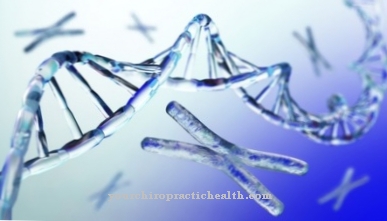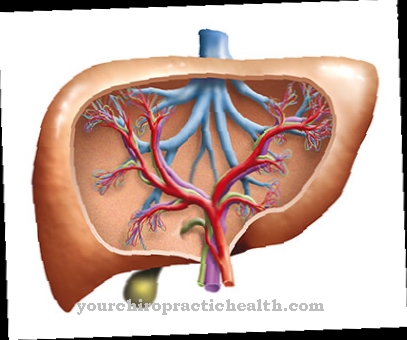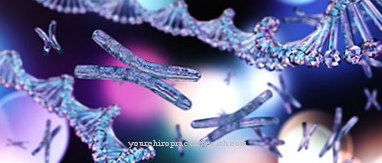Under Hypoglycemia one understands a drop in the blood sugar level below a value of approx. 60 mg / dl or 3.3 mmol / l. The Hypoglycaemia is not a disease of its own in the medical sense, but rather a condition caused by other circumstances or diseases.
What is hypoglycemia?
.jpg)
© Piman Khrutmuang - stock.adobe.com
One speaks of one Hypoglycemiaif the sugar level in the blood drops below certain values. Important organs such as the brain are not supplied with sufficient glucose (sugar), which can lead to neurological deficits.
A hypoglycemia can usually be recognized. on their symptoms, however, symptoms do not always have to be present. Depending on the severity of the hypoglycemia, the symptoms are divided into three groups.
The first symptoms - also called autonomic or adrenergic drawing - manifest as cravings, nausea, vomiting, sweating and racing heart. In the further course there are neurological deficits such as B. Confusion, impaired coordination and vision. The symptoms are signs that the glucose deficiency has already affected the central nervous system. This group of symptoms are known as neuroglycopenic signs.
If the hypoglycemia is left untreated, it can lead to paralysis, hypoglycemic shock, and seizures. The third group of symptoms are called unspecific signs. They are accompanying symptoms that are not characteristic of hypoglycaemia. However, nausea, dizziness and headaches can be the first signs of hypoglycaemia.
causes
The causes of a Hypoglycemia are very diverse. Often there are underlying diseases such as B. Diabetes mellitus. An excessively high dose of insulin can be the trigger for hypoglycaemia, so that we speak of so-called diabetic hypoglycemia.
Another form is what is known as reactive hypoglycaemia. This often affects overweight and obese people. A high intake of carbohydrates causes too much insulin to be released into the blood for a short time, which causes the sugar content to drop rapidly.
Other causes are strong physical stress at work as well as in sport, since this uses up the body's energy reserves, so that if the balance is not balanced, hypoglycaemia can occur. Alcohol abuse means that the body needs more sugar, as the organs need the energy to break down the alcohol. As a result of alcohol abuse, the liver is usually severely damaged, so that it is no longer able to store or regenerate glucose, or only to a limited extent.
The hormones also have an influence on the blood sugar level, as they are necessary helpers to produce glucose from amino acids. In various diseases such as For example, cancer, kidney disease and pancreatitis, various hormones such as cortisol can no longer be produced, which can lead to hypoglycaemia.
Medication, gluten and fructose intolerance and food allergies can also be causes of hypoglycaemia.
Symptoms, ailments & signs
Hypoglycemia manifests itself through symptoms such as cravings, tremors, and difficulty concentrating. In many patients, hypoglycaemia causes severe tiredness and fatigue, often associated with impaired consciousness. These symptoms are accompanied by increased irritability and inner restlessness. In individual cases, hypoglycaemia can cause skin irritation.
Those affected then temporarily suffer from severe itching and redness, which can appear all over the body. However, the hypoglycemia can also cause serious complications. If the hypoglycaemia is not corrected quickly, the person concerned can lose consciousness or even fall into a coma.
In less severe cases, hypoglycaemia makes the person affected very unwell. Usually there is also a feeling of illness that slowly declines after the blood sugar level has stabilized. Hypoglycaemia usually occurs suddenly or over the course of a few hours and persists for a few hours.
If the blood sugar level is balanced early, the symptoms and complaints can be reduced, but the concentration disorders and dizziness often persist for some time. In diabetic patients, hypoglycaemia can have life-threatening consequences. If the patient is not given insulin immediately, he or she may lose consciousness and fall into a diabetic coma.
Diagnosis & course
The diagnosis is made Hypoglycemia by the general practitioner. Symptoms such as tremors, sweating, cravings, and difficulty concentrating are the first signs. After the first examination, a so-called blood sugar test is carried out right at the beginning. With a small prick in the fingertip, a test strip is used to collect a small amount of blood, which can be evaluated on site using a blood glucose meter.
During the evaluation, it should be noted whether the patient is a diabetic or not. In non-diabetics, one speaks of hypoglycaemia below 60 mg / dl. In the case of diabetics, however, a value of less than 80 mg / dl can be considered hypoglycaemia, as they are usually used to higher blood sugar levels.
Mild hypoglycaemia such as B. can occur after physical activity, are relatively harmless. With more frequent occurrence, however, it can lead to habituation, so that life-threatening complications in the form of hypertension and CHD (coronary heart disease) can result.
Since hypoglycaemia is sometimes symptom-free, mild hypoglycaemia can be missed and the immediate result is severe hypoglycaemia. The course of severe hypoglycaemia with hypoglycemic shock may U. be life threatening. Since this condition is often associated with paralysis and loss of consciousness, immediate emergency medical help is necessary.
Studies in type 2 diabetics have found that recurrent severe hypoglycaemia increases the risk of developing dementia later.
Complications
The hypoglycaemia severely restricts the patient's life. It is not uncommon for those affected to faint and lose consciousness, which can mainly occur through strenuous physical activity or sporting activities. It comes to a concentration disorder and a coordination disorder. The person concerned suffers from cravings and often trembles.
Furthermore, an inner restlessness occurs and the patient suffers from sweating or panic attacks. If it comes to unconsciousness, the patient can injure himself in a possible fall or suffocate. As a rule, help from another person is always necessary. If the hypoglycaemia persists over a longer period of time, it can also lead to damage to the organs or to paralysis.
In many cases these are not reversible and therefore cannot be treated retrospectively. Hypoglycemia also increases the risk of dementia. In most cases, the acute treatment of hypoglycaemia is the addition of glucose. There are no further complications. The symptoms and consequential damage depend on the duration of the hypoglycaemia.
When should you go to the doctor?
If symptoms such as cravings, weakness, and tremors are noticed, the problem may be hypoglycemia. A doctor should be consulted if the symptoms persist for several days or recur within a few weeks. If there are other symptoms such as irritability, inner restlessness or poor concentration, medical advice is also required. Low blood sugar levels indicate diabetes or another serious condition that, if not already done, needs to be diagnosed and treated. A doctor should therefore be consulted at the first signs of hypoglycaemia.
If paralysis, panic attacks or coordination disorders occur, it is best to call the emergency doctor or the person concerned must be taken to the nearest clinic immediately. People who suffer from diabetes mellitus, cancer, pancreatitis or hormonal disorders should speak to their doctor if there are signs of hypoglycaemia. Overweight people and alcoholics are also among the risk groups that should clarify the symptoms mentioned immediately. It is best to see a pediatrician with children showing signs of low blood sugar.
Doctors & therapists in your area
Treatment & Therapy
When treating Hypoglycemia a distinction can be made between acute therapy and long-term therapy. The form of therapy depends on the blood sugar levels.
Immediate therapy can be as follows:
If the blood sugar level is less than 80 mg / dl, a meal is usually sufficient to rebalance the glucose balance.
At values below 60 mg / dl, one or two pieces of glucose (1 BE) help, so that the symptoms of hypoglycaemia regress. A blood sugar test should be carried out after approx. 30 minutes.
In the case of severe hypoglycaemia with values below 50 mg / dl, emergency medical care is urgently required, since only an intravenously administered dose of glucose can help to rebalance the blood sugar balance. In addition, close blood sugar controls are necessary over a longer period of time.
The long-term therapy includes intensive education of the person concerned at the beginning. If a diabetic has hypoglycaemia, relatives should also learn how to use pre-filled glucagon syringes so that they can be injected into the thigh or buttocks of the person concerned in an emergency.
prevention
Preventive measures for a Hypoglycemia are i.a. the education and training of those affected and their relatives. Those who frequently suffer from hypoglycaemia should regularly check their blood sugar levels. There are inexpensive devices for domestic use that can be carried with you due to their handiness.
It is important that those affected eat regularly and healthily, especially when they are under physical strain. Alcohol should be avoided. Patients should always have glucose with them for immediate therapy. Furthermore, it makes sense to keep a hypoglycaemia diary in which it is noted when and during which activities the hypoglycaemia occurs.
Aftercare
Hypoglycemia (low blood sugar) requires follow-up care even after timely and successful treatment. This applies on the one hand to the regeneration of the weakened organism and on the other hand to the prevention of renewed hypoglycemia. First of all, the patients affected by hypoglycaemia allow themselves physical rest and also avoid mental agitation.
Both have an effect on the blood sugar level, which, however, should be kept at a stable level after successfully treated hypoglycemia as long as the person has to recover from the disease. Part of the aftercare is therefore the initial abstinence from exercise, which must be maintained for a long time. In addition, with a view to the future, measures must be planned to counteract hypoglycaemia during exercise.
Above all, this includes regular meal breaks and, if necessary, measuring the blood sugar level. The same applies to the working life of the patient, especially when more or less physically strenuous activities are performed. Follow-up care for disease-related hypoglycaemia also includes developing an adequate menu.
This includes not only the type and amount of meals, but also the times they are taken. A professional nutritionist can offer useful support. In addition, those affected make regular check-ups with their doctor in order to keep an eye on the long-term sugar values in the blood and to be able to react quickly if necessary.
You can do that yourself
Hypoglycaemia can have a number of different causes. The self-help measures the patient can take will depend on what is causing the disorder.
For example, hypoglycaemia can result from diabetes mellitus. Hypoglycaemia can occur again and again in diabetics who are poorly adjusted with medication. Those affected can counteract this by having their blood sugar level tested regularly and also using the prescribed medication according to the instructions.
Overweight people who are prone to binge eating often suffer from reactive hypoglycaemia. If too many carbohydrates are ingested during an eating attack, the body reacts to this with excessive insulin release, which can cause the blood sugar level to drop drastically. If this happens frequently, those affected have to change their diet. This may require the help of a therapist in the case of addictive behavior. This also applies to people whose sugar level is regularly too low due to continued alcohol abuse. If high amounts of alcohol are consumed, the body uses more sugar to break down the toxin again. A liver that has already been damaged by alcohol can only store little glucose, which exacerbates the problem.
In addition, vigorous physical exertion, for example during sport, can lead to the consumption of more sugar than is consumed. This can be prevented by taking regular breaks and taking small snacks.

.jpg)


























